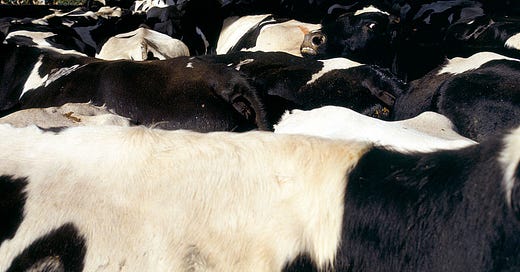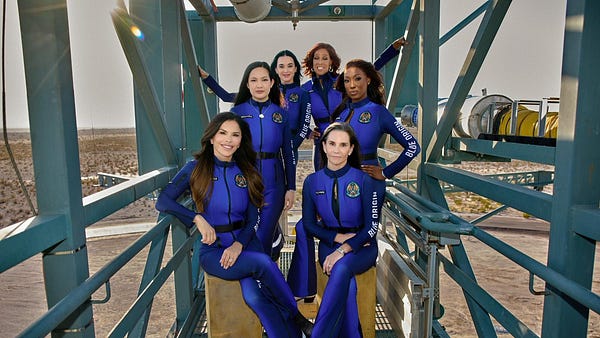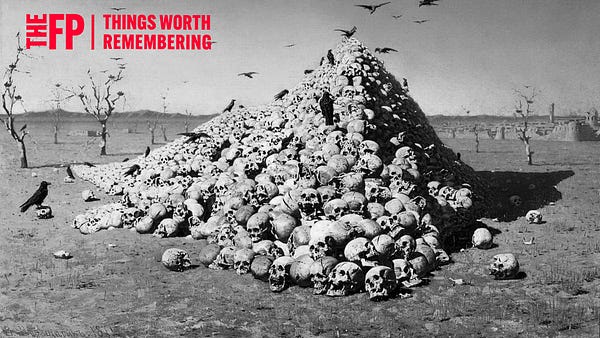
The Free Press

Before his conversion, Kale Hyder—a 23-year-old Morgan Stanley analyst who lives in Baltimore—was one of those trendy, enviro-conscious consumers who buy Oatly and Beyond Meat patties at the grocery store. These days he barely goes to the grocery store at all, and certainly not for plant-based replicas of milk and meat.
Blame it on the price of Bitcoin. When the price was shooting up in late 2020, Hyder went on Twitter to see what all the fuss was about. “I quickly realized they talked about a lot more than price fluctuations,” he told me. One account, @modernTman, was obsessed with food and with “decentralizing beef.” The industry is dominated by four packers—Cargill, Tyson Foods, JBS, and National Beef Packing—who together are like the Fed of red meat. For @modernTman and his followers, sourcing their own meat and raw milk—like investing their money in Bitcoin to escape the clutches of traditional banks—was about wresting back control they believed the government had taken away.
So what about those cartons of Oatly and synthetic burgers?
“I’m completely against that stuff now,” says Hyder, whose new thing is “whole foods”—including sirloin, raw butter with Celtic sea salt, grass-fed raw milk cottage cheese, and raw milk.
It’s illegal to sell raw milk for human consumption in Maryland, but you can buy it from farmers as pet food. Still, it’s hard to come by unless you live in the sticks. Hyder spent a few weekends driving through the country in search of milk that’s unpasteurized, unhomogenized, untreated, and—depending on where you get it—untested for salmonella, listeria, and E. coli.
“Five hundred years ago, humans were drinking raw milk,” he says. “They didn’t have processing plants that heated the milk or whatever. It’s about returning to, ‘What did we do that got us here?’ ”
Before 2000, there were differences of opinion about skim or one- or two-percent, but those differences were largely kept in check by The Great Milk Consensus. It held that in general, milk was to be pasteurized, homogenized, and come from the udder of a cow. The Williams sisters, Kate Moss, and Beyoncé all hawked it at the height of their powers, sporting milk mustaches in the famous “Got Milk?” ads.
Over the past two decades, though, that consensus has been blown up.
First came soy milk, which managed to weave together environmentalism, veganism, and a diet culture that said milk fat was bad for our waistlines and cholesterol. The brand Silk launched into the dairy aisle in 1996, and got big right around the same time The New England Journal of Medicine—and later the Food and Drug Administration—reported that eating soy reduced the risk of heart disease (which the FDA later walked back).
A decade later, almond milk—which was popular in the Middle Ages—became the thing. Then came the explosion of other nut and seed and plant milks: cashew, hazelnut, hemp, flax, macadamia, walnut, pea, and quinoa, to name just a few. This was during the second Obama and Trump administrations, when everyone became hypersensitive about their palates and politics, and devised increasingly more elaborate coffee orders.
Then, around 2017, when #MeToo was ascendant and kneeling football players were all anyone was talking about, oatmilk exploded onto the scene. It was from Sweden! And don’t you know how many gallons of water it takes to produce a single almond? Within a year, New York City was facing a serious oatmilk shortage. And in 2021, Oatly went public with a $10 billion market valuation.
Which brings us to today.
If every milk fad reflects the politics and culture of its moment, what does it say about us that the backlash to soy and nuts of all varieties has arrived, and it’s finally back to the bovine? And not just cow’s milk, but cow’s milk of the pure and unadulterated variety. Not just raw, but derived from A2 cows—a genetic strain whose milk is purportedly better for digestion.
The appeal of all of this is twofold. First, raw milk represents a time before everything got screwed up and filled with xanthan gum and phosphates and seed oils—a halcyon era. And second, since raw milk is unpasteurized, it’s also a little bit dangerous—as the medical establishment has warned. It’s a challenge. It’s forbidden. And when you don’t trust the institutions forbidding it, the draw is all the greater.
Just listen to Joshua Rainer.
“My eyes lit up—it’s like the truth hit me,” says Rainer, 32, a personal-trainer-turned-farmhand who moved from California to Colorado after going deep into the world of raw milk. Rainer had his first sip in 2013, after his boss at the CrossFit gym where he worked told him he had to go raw.
He did just that, going online and ordering several gallons of totally unmolested milk from a farm in Pennsylvania. A little more than a week later, a delivery truck deposited his first shipment, packed in glass jars, in the parking lot next to his gym.
Growing up, Rainer’s parents had fed him fat-free and skim milk from the store—“whatever was blue,” he says.
But this raw milk from the unincorporated town of Bird-in-Hand—deep in the heart of Amish country—was unbelievably thick. He didn’t know he had to shake it to incorporate the cream with the milk; the kind he’d always bought at the grocery store had been homogenized, meaning it didn’t come with a layer of cream on top. He used a ladle to scoop it out.
For the past year and a half, Rainer has been milking cows every day—plus building fences, and washing, feeding, and slaughtering animals at the farm where he’s employed. In a few years, he hopes to have his own.
“It’s just real,” he told me. “When I give it to people, they ask if there’s vanilla in it, because it’s so sweet, but it’s just that I squeezed it out of a cow a couple of hours ago.” He refers to the moment he first tasted raw milk—or as he calls it, “liquid gold”—as “this kind of life-changing point.”
Farmers, hippies, health nuts, and crunchy cons—the conservative writer Rod Dreher’s term for GOP voters who also wear Birkenstocks and shop at farmer’s markets—have been drinking raw milk for decades. But the past few years have seen a dramatic uptick in raw-milk consumption. “The appeal of raw milk is that it’s an unprocessed and natural food,” says David Gumpert, who blogs about politics and food, and wrote The Raw Milk Revolution. “Milk is the first nurturing food that mammals have, including humans, so it has a lot of symbolism in that way.”
And for new consumers, raw milk is a symbol. Most states don’t allow it to be sold in stores—just twelve do. But most also have loopholes for the determined and savvy, and more states are giving it the legal go ahead. The Missouri state legislature has two bills on the docket of its coming session that would legalize retail sales of raw milk. A similar law in Georgia will go into effect this summer. But for now, to drink (and, especially, to produce) raw milk is a way of breaking with convention and raging against the machine—the United States Department of Agriculture, the Centers for Disease Control, the FDA, doctors, PhDs, state regulators, and Big Dairy—all while engaging in caveman-inspired biohacking.
Raw milkers want control over their lives, and that includes their food—where it comes from, who farms it, how it gets to them.
If it takes longer to get something—and raw milk can take a really long time, given that you have to find a local producer, hope that the cows at your farm stay healthy and productive, and take steps to ensure that you won’t get busted—that’s okay. That just makes it more real. “The idea of convenience has definitely shifted for me,” says Hyder, who, before 2020, was happy to get next-day delivery on Amazon. “I’ve become more skeptical if things are easy, because it likely means there were shortcuts.”
In 2018, Connor, 31, a Seattle-based software engineer who didn’t want to give me his last name for privacy reasons, started the website GetRawMilk, which cataloged every raw milk seller in Washington State. Soon after, he expanded to the whole country—and then the globe. “This is my way of giving back as an engineer,” he told me. Unique visitors to his site have doubled since the beginning of 2022, he says.
“I want my kid to go into real life,” Joshua Rainer says of his seven-month-old son. “I don’t want him put in a weird incubation bubble for twenty years.”
Benjamin Beichler, 35, who runs a dairy in Middlebrook, Virginia with his wife, hears versions of that sentiment daily. He hasn’t been able to keep raw milk in stock. “Raw milk has taken on a new tone since Covid,” he told me. “Some people decided to wait for a vaccine or a cure, and others decided to look into making themselves healthier.”
Beichler observes that a lot of those people had lost faith in the National Institutes of Health—and the dollar. “I’ve had a few people ask me if they can pay for raw milk in Bitcoin,” he says.
For now, raw milk inhabits a gray market—and a gray legal zone.
In 1987, the FDA mandated that milk be pasteurized. That made interstate sales of raw milk illegal, but each state could decide for itself whether to legalize the stuff. Eight states—including West Virginia, Michigan, Tennessee, and Colorado—allow for herdshares, in which customers are part-owners of the dairy from which they get their raw milk. In Maryland, there’s the dog or cat food workaround. In Rhode Island, you just need a doctor’s note. In Oregon, if you have three or fewer lactating dairy cows, you can sell their milk without a license.
So while laws are generally lax, police raids targeting illegal sales or unsanitary facilities are not unheard of. The latest flashpoint was over Amos Miller Organic Farm, where camels, cows, pigs, poultry, and goats roam free—and which was the portal through which Rainer and several other people I spoke to entered the raw milk world.
Miller’s site proclaims, “We enjoy good ol’ farming the natural way.” It’s become a cause célèbre among the anti-establishment, neo-traditionalist set, since Miller is being sued for $305,000 by the federal government over his refusal to adhere to health standards. Miller recently fired his old attorney in favor of Robert Barnes, the lawyer who has represented Kyle Rittenhouse, Alex Jones, and the Covington Catholic high school student Nick Sandmann. Referring to the Miller case, Barnes told The Lancaster Patriot, “It’s about what can you farm, and what do we eat. And do we control that, or is it the government?”
John Sheehan, former director of the FDA’s Division of Plant and Dairy Food Safety, famously compared drinking raw milk to “playing Russian roulette with your health.” But Preethi Kasireddy, 32, doesn’t see it that way.
She lives outside of Houston with her personal trainer husband and their six-month-old baby. She was a partner at Andreessen Horowitz, the prominent venture capital firm in Silicon Valley, and then she worked as an engineer at Coinbase before launching her own start-up: a coding bootcamp for Web3 developers. But three years ago, after having been on birth control, she stopped getting her period. Soon after, she shut down her company and refocused on her health. She started reading about foods that might help her get pregnant.
“Modern medicine failed me,” Kasireddy says. “I had to go down the rabbit hole.”
That led her to raw milk—specifically to Miller’s farm—which reminded her of the raw buffalo milk that her family in India drank. She’d tried all kinds of milk—pasteurized whole milk from a carton, almond, cashew. Now, she drinks about a gallon and a half of raw cow’s milk weekly. “There’s a lot of fearmongering around raw foods,” she says.
But for all the debate and discussion about shelf life, bacteria, and which additives or cattle feed are bad or good, the nub of the milk wars is about authenticity, and what counts as real in a world of counterfeits. The government, the media, Big Dairy—they insist they’re just trying to keep everyone healthy. The raw milkers say the establishment has gone overboard. ”By trying to be super, super safe, they’ve completely destroyed the health aspect of milk,” Kasireddy says.
Raw milk, she says, is about tunneling back to what’s been lost. It represents a nostalgia for simpler times, when people weren’t so fussy, when there weren’t so many choices. When human beings couldn’t engineer a “healthier,” leaner, cheaper version of any food they craved.
“Why do the people who create Beyond Meat burgers think they can create a better patty than nature can produce?” Kale Hyder asks.
Joshua Rainer agrees. “Milk comes from the breast of a mammal,” he says. “It’s not a nut juice that’s been strained, then filled with all kinds of oils and chemicals and preservatives. People are just grasping for anything that’s real, not AI or virtual reality or pasteurized oatmilk.”
Read all of Suzy’s work for The Free Press here.














That year I drank Amish raw milk delivered to DC and ate raw yogurt, butter, made my own clabber from raw milk--that was the only year in about 40 years I had no allergies and didn't catch a cold. And I was so happy because the food I ate was delicious and fresh, and dairy has always been my favorite food. There is nothing in the world like raw dairy if you love cheese, milk, clabber, kefir, yogurt. I was invited to meet the family who produced it all and went. I'm SOOO glad our new gov. Landry's made it legal finally in Louisiana so I can get it legally locally.
I grew up on a dairy farm, milking cows every day, and all we drank as kids was raw milk. It is delicious! When I went to school and drank milk from a carton I couldn't believe how bad it tasted. My siblings and I grew up very healthy!